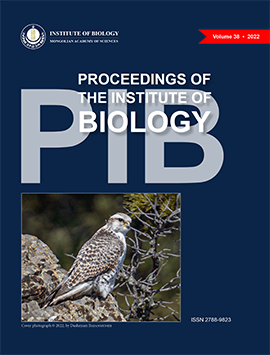Classification of Pest Damaged Trees with Multi-Temporal Sentinel-2 Data
DOI:
https://doi.org/10.5564/pib.v38i1.2540Keywords:
Random Forest, remote sensing, forest pest insects, forest researchAbstract
The Forest covers 8 percent of the land in Mongolia. In the last 20 years, 1.2 million ha area has been lost due to forest fires, pests damages, and illegal cutting. There are many ways to determine the state of forests in Mongolia, but there is an urgent need to introduce new technical and technological achievements that have appeared in recent years.
This study focuses on assessing the potential of Sentinel-2 satellite images and the Random Forest (RF) classifier for mapping forest cover in part of the Bayan Davaа forest in Mongolia.
Хөнөөлт шавжийн нөлөөнд өртсөн ойн талбайг сансрын “Сентинел-2” хиймэл дагуулын өгөгдөлөөс илрүүлэх боломж
Монгол орны нийт нутаг дэвсгэрийн найм орчим хувийг ой бүхий талбай эзлэх бөгөөд сүүлийн 20 гаруй жилийн
хугацаанд 1.2 сая га талбай нь ойн түймэр, хортон шавжийн нөлөө болон хууль бусаар мод бэлтгэх үйл ажиллагааны
уршигаар хорогдсон. Монгол орны ойн төлөв байдлыг тодорхойлох олон арга байх боловч сүүлийн жилүүдэд гарч
буй шинэ техник технологийн ололт амжилтыг нэвтрүүлэх зайлшгүй шаардлага тулгарсаар байна. Энэхүү судалгааны
хүрээнд Төв аймгийн Эрдэнэ сумын нутаг дэвсгэрт орших Баян давааны арын баруун хойд налууд орших ойн төлөв
байдлыг үнэлэхдээ Сентинел-2 (Sentinel-2) хиймэл дагуулаас илгээгдсэн зураглалд боловсруулалт хийж “бүлэглэн
ялгах” (Random Forest) арга зүйг туршив.
Түлхүүр үгс: Random Forest, зайнаас тандан судлах, хөнөөлт шавж, ойн судалгаа
Downloads
357
References
R. Hale Topaloğlu, E. Sertel, and N. Musaoğlu, “Assessment of Classification Accuracies of SENTINEL-2 and LANDSAT-8 Data for Land Cover / Use Mapping,” ISPRS - Int. Arch. Photogramm. Remote Sens. Spat. Inf. Sci., vol. 41B8, pp. 1055–1059, Jun. 2016, https://doi.org/10.5194/isprs-archives-XLI-B8-1055-2016.
M. L. Clark and D. A. Roberts, “Species-Level Differences in Hyperspectral Metrics among Tropical Rainforest Trees as Determined by a Tree-Based Classifier,” Remote Sens., vol. 4, no. 6, Jun. 2012, https://doi.org/10.3390/rs4061820.
S. L. Ustin et al., “Retrieval of foliar information about plant pigment systems from high resolution spectroscopy,” Remote Sens. Environ., vol. 113, no. Suppl.1, pp. S67–S77, 2009, https://doi.org/10.1016/j.rse.2008.10.019.
M. L. Clark, D. A. Roberts, and D. B. Clark, “Hyperspectral discrimination of tropical rain forest tree species at leaf to crown scales,” Remote Sens. Environ., vol. 96, no. 3, pp. 375–398, Jun. 2005, https://doi.org/10.1016/j.rse.2005.03.009.
G. P. Asner, “Biophysical and Biochemical Sources of Variability in Canopy Reflectance,” Remote Sens. Environ., vol. 64, no. 3, pp. 234–253, Jun. 1998, https://doi.org/10.1016/S0034-4257(98)00014-5.
M. Drusch et al., “Sentinel-2: ESA’s Optical High-Resolution Mission for GMES Operational Services,” Remote Sens. Environ., vol. 120, pp. 25–36, May 2012, https://doi.org/10.1016/j.rse.2011.11.026.
P. Thanh Noi and M. Kappas, “Comparison of Random Forest, k-Nearest Neighbor, and Support Vector Machine Classifiers for Land Cover Classification Using Sentinel-2 Imagery,” Sensors, vol. 18, no. 1, Jan. 2018, https://doi.org/10.3390/s18010018.
M. Persson, E. Lindberg, and H. Reese, “Tree Species Classification with Multi-Temporal Sentinel-2 Data,” Remote Sens., vol. 10, no. 11, Nov. 2018, https://doi.org/10.3390/rs10111794.
A. Waśniewski, A. Hościło, B. Zagajewski, and D. Moukétou-Tarazewicz, “Assessment of Sentinel-2 Satellite Images and Random Forest Classifier for Rainforest Mapping in Gabon,” Forests, vol. 11, no. 9, Sep. 2020, https://doi.org/10.3390/rs10111794.
Dugarjav. Ch, Dorjsuren. Ch, and Chuluunbaatar. Ts, “Directory of Forest Taxation of Mongolia”. Ulaanbaatar: Bambi Foundation, 2012. (in Mongolian)
Ministry of Policy and Regulation, Ministry of Education, Culture, Sports, Science and Technology, “Report of external control and monitoring of forest insect control in some Sum Gorkhi-Terelj National Parks of Central, Khentii, and Dorno provinces.” 2018. (in Mongolian)
Grand Forest LLC, “Forest Management Report,” Erdene Sum, Central Province. (in Mongolian)
“Wayback Machine,” Apr. 30, 2015. https://web.archive.org/web/20150430211022/http://www.copernicus.eu/sites/default/files/library/Interim_Evaluation_of_the_GMES_Initial_Operations.pdf (accessed Oct. 18, 2022).
“S2-PDGS-MPC-L2A-SRN-V2.9.0.pdf.” Accessed: Oct. 18, 2022. [Online]. Available: http://step.esa.int/thirdparties/sen2cor/2.9.0/docs/S2-PDGS-MPC-L2A-SRN-V2.9.0.pdf
F. Morandat, B. Hill, L. Osvald, and J. Vitek, “Evaluating the Design of the R Language,” in ECOOP 2012 – Object-Oriented Programming, Berlin, Heidelberg, 2012, pp. 104–131. https://doi.org/10.1007/978-3-642-31057-7_6.
L. Breiman, “Random Forests,” Mach. Learn., vol. 45, no. 1, pp. 5–32, Oct. 2001, https://doi.org/10.1023/A:1010933404324.
M. Belgiu and L. Drăguţ, “Random forest in remote sensing: A review of applications and future directions,” ISPRS J. Photogramm. Remote Sens., vol. 114, pp. 24–31, Apr. 2016, https://doi.org/10.1016/j.isprsjprs.2016.01.011.
R. Dorfman, “A Formula for the Gini Coefficient,” Rev. Econ. Stat., vol. 61, no. 1, pp. 146–149, 1979, https://doi.org 10.2307/1924845.
K. M, “Package ‘caret’, Classification and regression Training.”
M. Kuhn, “Building Predictive Models in R Using the caret Package,” J. Stat. Softw., vol. 28, pp. 1–26, Nov. 2008, https://doi.org/10.18637/jss.v028.i05.
M. Nelson, Evaluating Multitemporal Sentinel-2 data for Forest Mapping using Random Forest. 2017. Accessed: Oct. 18, 2022. [Online]. Available: http://urn.kb.se/resolve?urn=urn:nbn:se:su:diva-146657
Downloads
Published
How to Cite
License
Copyright (c) 2022 Duinkherjav Bayarmaa, Gankhuyag Gantulga, Chuluunbaatar Gantigmaa, Dashzeveg Ganbat

This work is licensed under a Creative Commons Attribution-NonCommercial 4.0 International License.
Copyright on any research article in the Proceedings of the Institute of Biology is retained by the author(s).
The authors grant the Proceedings of the Institute of Biology license to publish the article and identify itself as the original publisher.
![]()
Articles in the Proceedings of the Institute of Biology are Open Access articles published under a Creative Commons Attribution-NonCommercial 4.0 International License - CC BY NC.
This license permits use, distribution and reproduction in any medium, provided the original work is properly cited.




